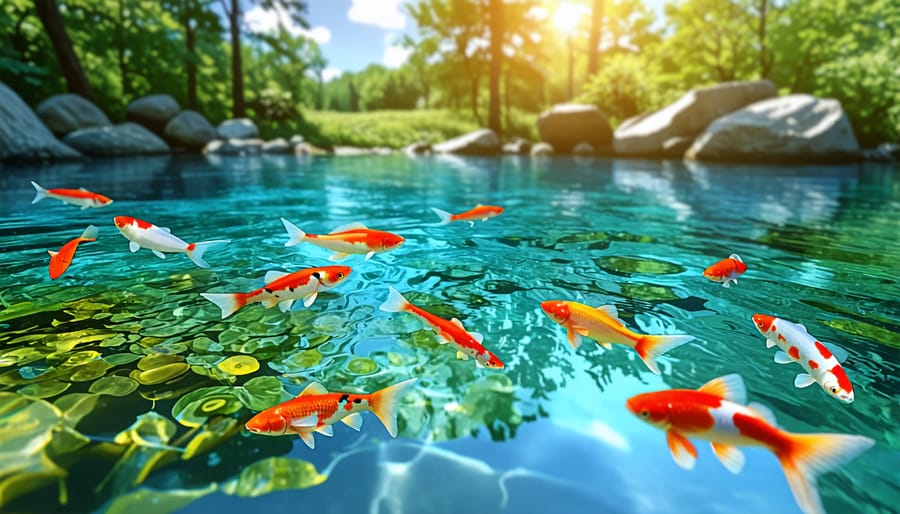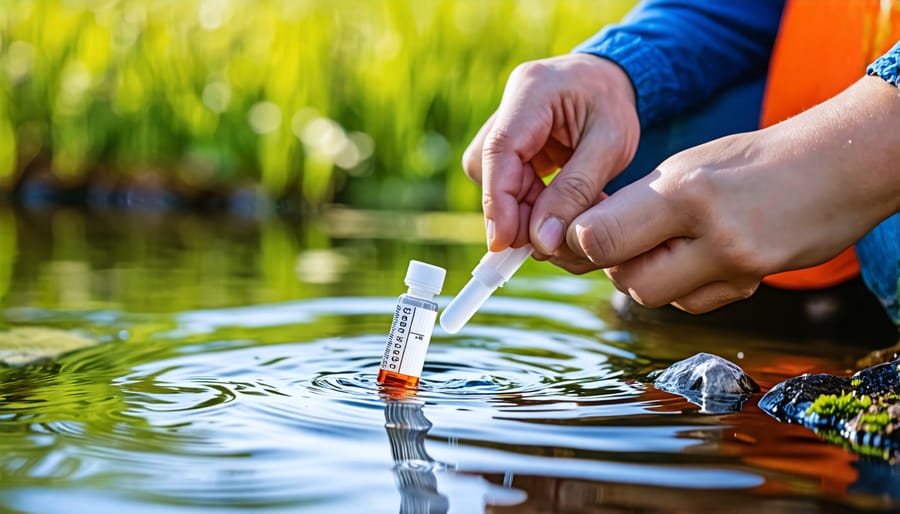
7 Pond Diseases Sabotaging Your Water Garden (And How to Beat Them)
Beware the silent killers lurking in your backyard pond’s tranquil waters. Pond diseases can quickly turn your aquatic haven into a cesspool of suffering and death. These microscopic menaces prey on your pond’s most vulnerable inhabitants – fish, plants, and amphibians. Left unchecked, they multiply with terrifying speed, leaving trails of rotting flesh and decimated populations in their wake.
Don’t let your pond become a watery graveyard. Arm yourself with knowledge to spot the warning signs and crush these outbreaks before they consume all you hold dear. In this article, we’ll expose the most ruthless pond pathogens, reveal their malevolent machinations, and equip you with the weapons to win the war raging beneath the surface.
The battle for your pond’s soul starts now. Dare you dive in and confront the face of aquatic evil? Steel your nerves and read on – your pond’s fate hangs in the balance.

Common Pond Diseases
1. Fish Fungal Infections
Fungal infections in pond fish are commonly caused by Saprolegnia, a type of water mold that thrives in poor water conditions. Stress, injuries, or a weakened immune system can make fish more susceptible to these infections. Symptoms include white, cottony patches on the skin, fins, or gills, lethargy, loss of appetite, and irregular swimming behavior. To treat fungal infections, start by improving water quality through regular testing and maintenance. Isolate affected fish in a quarantine tank and apply antifungal medications like malachite green or methylene blue as directed. Mild cases may resolve with salt baths, which can help remove the fungus and promote healing. Prevent future outbreaks by maintaining optimal water parameters, avoiding overcrowding, and providing a nutritious diet to support fish health. If the infection persists or spreads, consult a veterinarian specializing in fish care for further guidance and treatment options.

2. Bacterial Fin Rot
Bacterial fin rot is a common ailment that can affect pond fish, causing frayed, ragged, or disintegrating fins. Telltale signs include red, inflamed fin bases and milky white patches on the fins. Poor water quality, overcrowding, and stress are the primary culprits behind this disease. To treat bacterial fin rot, start by improving water conditions through regular testing and maintenance. Isolate affected fish in a quarantine tank and administer a broad-spectrum antibiotic treatment as directed. Prevent future outbreaks by maintaining optimal water parameters, avoiding overcrowding, and minimizing stress factors such as aggressive tankmates or sudden changes in environment. With prompt intervention and a commitment to providing a clean, healthy habitat, your pond fish can recover from bacterial fin rot and thrive in their aquatic home.
3. Parasitic Infestations
Fish parasites like anchor worms, fish lice, and skin flukes can quickly infest your pond, causing distress and disease in your aquatic pets. These parasites attach to the fish’s skin, gills, or fins, feeding on their blood and tissue. To eradicate them, start by quarantining infected fish in a separate tank for treatment. Use anti-parasitic medications like formalin, malachite green, or praziquantel, following the instructions carefully. Maintain optimal water quality in your pond by regularly testing and adjusting parameters, performing water changes, and avoiding overfeeding. Boost your fish’s immune system with a balanced diet and reduce stress factors. In severe cases, you may need to treat the entire pond with a broad-spectrum anti-parasitic. Prevent future infestations by quarantining new fish before introducing them to your pond and avoiding contact with contaminated water or equipment. With prompt action and proper care, you can successfully rid your pond of parasites and keep your fish healthy.
4. Algal Blooms
Algal blooms occur when excess nutrients, particularly phosphorus and nitrogen, build up in the pond water, fueling rapid algae growth. Common causes include overfeeding fish, fertilizer runoff from nearby landscaping, and decomposing organic matter like fallen leaves. To control algal blooms, start by reducing nutrient input. Feed fish only what they can consume in a few minutes and remove any uneaten food. Plant water lilies or floating plants to shade the pond surface, limiting sunlight that promotes algae growth. Regularly remove debris and consider installing a pond skimmer to capture floating leaves. Introduce beneficial bacteria to break down organic matter and compete with algae for nutrients. In severe cases, a UV clarifier can help eliminate suspended algae, while a partial water change can dilute excess nutrients. Maintaining a balanced ecosystem with proper filtration, aeration, and regular maintenance is key to keeping algal blooms in check.
5. Planktonic Diseases
Certain microscopic algae and bacteria can rapidly multiply in ponds, causing harmful blooms that disrupt the ecosystem. Blue-green algae, or cyanobacteria, are notorious for producing toxins that harm fish, plants, and even humans. Diatoms, another type of planktonic algae, can cloud water and deplete oxygen levels when they die off en masse. To prevent these issues, maintain proper nutrient balance, ensure adequate filtration, and consider using beneficial bacteria to outcompete the harmful species. Regular water testing can help detect imbalances early on. If a harmful bloom occurs, treat promptly with appropriate algaecides or water conditioners, following product instructions carefully. Severe cases may require professional intervention to restore pond health. By staying vigilant and proactive, you can minimize the risk of planktonic diseases and keep your pond thriving.
6. Viral Hemorrhagic Septicemia
Viral hemorrhagic septicemia (VHS) is a deadly virus that affects various fish species, causing internal bleeding and organ failure. While it primarily impacts salmon and trout, it can also infect ornamental pond fish like koi and goldfish. VHS spreads through contact with infected fish, contaminated water, or equipment. Symptoms include bulging eyes, bloating, pale gills, and red spots or hemorrhaging on the skin and internal organs. Unfortunately, there is no cure for VHS, and it can lead to significant fish mortality. To prevent the disease, quarantine new fish for at least 30 days before introducing them to your pond, avoid sharing equipment between ponds, and maintain optimal water quality. If you suspect VHS, contact a fish health professional immediately for guidance on minimizing its spread and protecting your remaining fish population.
Proactive Pond Disease Prevention
Proper Pond Maintenance
Regular cleaning and water changes are essential for maintaining a healthy pond and proper pond maintenance. To minimize disease risk, start by removing debris like fallen leaves, twigs, and excess plant matter on a weekly basis. This organic waste can quickly decompose, leading to poor water quality and creating an environment conducive to disease-causing pathogens.
Next, perform partial water changes every few weeks, replacing about 10-20% of the pond water with fresh, dechlorinated water. This helps dilute buildup of harmful toxins and keeps water parameters in check. Regularly clean filters to ensure optimal performance and maintain good water circulation.
Additionally, avoid overfeeding fish, as uneaten food can contribute to water pollution. Stick to a balanced feeding schedule and only provide what they can consume within a few minutes.
Monitor water quality parameters like pH, ammonia, nitrite, and nitrate levels using a reliable test kit. Addressing any imbalances promptly can prevent stress on fish and plants, which weakens their immune systems and makes them more susceptible to diseases.
By dedicating time to these regular maintenance tasks, you’ll create a thriving, disease-resistant pond ecosystem that provides year-round enjoyment.
Quarantining New Fish
When introducing new fish to your pond, it’s crucial to quarantine them first to prevent the spread of diseases. Set up a separate tank or container with clean, dechlorinated water and maintain optimal conditions. Observe the new fish closely for at least two weeks, watching for signs of illness such as abnormal behavior, loss of appetite, or visible lesions. Treating any issues promptly in quarantine protects the health of both the new arrivals and your existing pond inhabitants.
During the quarantine period, avoid sharing equipment between the isolation tank and your main pond to minimize cross-contamination risks. Gradually acclimate the new fish to your pond’s water parameters by slowly mixing in small amounts of pond water over several days. This process helps reduce stress and allows the fish to adjust smoothly to their new environment. With patience and diligence in quarantining, you’ll be rewarded with a thriving, disease-free pond community.

Maintaining Optimal Water Parameters
Maintaining optimal water parameters is crucial for preventing pond diseases and ensuring the health of your aquatic ecosystem. The ideal temperature range for most pond fish is between 65-75°F (18-24°C). pH levels should be kept stable between 6.5-8.5, with a slight alkalinity being optimal for most species. Adequate oxygen levels are essential, which can be maintained through proper aeration and water circulation. Aim for dissolved oxygen levels above 5 mg/L. Regularly monitor and control nutrient levels, such as ammonia, nitrites, and nitrates, to prevent harmful spikes that can stress fish and promote disease. Ammonia and nitrite levels should be kept as close to zero as possible, while nitrates should be below 50 ppm. By regularly testing and adjusting your water parameters, you can create a stable and healthy environment that minimizes the risk of disease outbreaks in your pond.
Conclusion
In conclusion, understanding and managing pond diseases is crucial for maintaining a healthy and thriving water garden ecosystem. By familiarizing yourself with common pond ailments, their causes, and treatment options, you can take proactive measures to prevent outbreaks and address issues promptly. Remember to prioritize water quality, maintain proper filtration, and quarantine new plants or fish before introducing them to your pond. Regularly monitor your pond inhabitants for signs of distress and take swift action when necessary. With vigilance, care, and a commitment to best practices, you can create a beautiful and resilient pond that brings joy for years to come. Stay informed, stay proactive, and enjoy the rewarding experience of nurturing a vibrant aquatic oasis in your own backyard.
